Exploring Tradeoffs in Merged Pipeline Infrastructure for Carbon Dioxide Integration Networks
Abstract
1. Introduction
2. Materials and Methods
2.1. Mathematical Model
3. Results
3.1. Case Study Data
3.2. Case Study Results
4. Discussion
5. Conclusions
Author Contributions
Funding
Conflicts of Interest
Nomenclature
| Total cost of compression ($/y) | |
| Total cost of pumping ($/y) | |
| Cost of pipe segment ($/y) | |
| Pressure difference in pipe segment (bar) | |
| Pressure drop parameter associated with pipe segment (bar) | |
| Elec. | Electricity price in $/kWh |
| D | Diameter of pipe (m) |
| Outlet velocity of source s to sink k (m/s) | |
| Molecular mass of carbon dioxide g/mol | |
| CRF | Capital Recover Factor |
| F | Mass flowrate in pipe (m3/s) |
| Temperature of carbon dioxide source (°C) | |
| L | Length of pipe segment (m) |
| Cost parameter of the pipe segment ($/y) | |
| Power parameter for the compressor ($/y) | |
| Capital cost of compression ($/y) | |
| Operating cost of compression ($/y) | |
| Capital cost of pumping ($/y) | |
| Operating cost of pumping ($/y) |
References
- Tapia, J.; Lee, J.Y.; Ooi, R.; Foo, D.; Tan, R. A review of optimization and decision-making models for the planning of CO2 capture, utilization and storage (CCUS) systems. Sus. Prod. Consump. 2018, 13, 1–15. [Google Scholar]
- Eide, L.; Batum, M.; Dixon, T.; Elamin, Z.; Graue, A.; Hagen, S.; Hovorka, S.; Nazarian, B.; Nøkleby, P.; Olsen, G.; et al. Enabling Large-Scale Carbon Capture, Utilisation, and Storage (CCUS) Using Offshore Carbon Dioxide (CO2) Infrastructure Developments—A Review. Energies 2019, 12, 1954. [Google Scholar] [CrossRef]
- Leung, D.Y.C.; Caramanna, G.; Maroto-Valer, M.M. An overview of current status of carbon dioxide capture and storage technologies. Renew. Sus. Energ. Rev. 2014, 39, 426–443. [Google Scholar] [CrossRef]
- Shahbazi, A.; Nasab, B.R. Carbon Capture and Storage (CCS) and its Impacts on Climate Change and Global Warming. J. Pet. Environ. Biotechnol. 2016, 7, 1000291. [Google Scholar] [CrossRef]
- Mikkelsen, M.; Jorgensen, M.; Krebs, F. The teraton challenge. A review of fixation and transformation of carbon dioxide. Energ. Environ. Sci. 2010, 3, 43–81. [Google Scholar] [CrossRef]
- Dai, Z.; Middleton, R.; Viswanathan, H.; Fessenden-Rahn, J.; Bauman, J.; Pawar, R.; Lee, S.-Y.; McPherson, B. An Integrated Framework for Optimizing CO2 Sequestration and Enhanced Oil Recovery. Environ. Sci. Tec. Let. 2014, 1, 49–54. [Google Scholar] [CrossRef]
- Xiaoding, X.; Moulijn, J.A. Mitigation of CO2 by chemical conversion: Plausible chemical reactions and promising products. Energ. Fuels 1996, 10, 305–325. [Google Scholar] [CrossRef]
- Kongpanna, P.; Pavarajarn, V.; Gani, R.; Assabumrungrat, S. Techno-economic evaluation of different CO2-based processes for dimethyl carbonate production. Chem. Eng. Res. Des. 2015, 93, 496–510. [Google Scholar] [CrossRef]
- Dimitriou, I.; García-Gutiérrez, P.; Elder, R.H.; Cuéllar-Franca, R.M.; Azapagic, A.; Allen, R.W.K. Carbon dioxide utilisation for production of transport fuels: Process and economic analysis. Energ. Environ. Sci. 2015, 8, 1775–1789. [Google Scholar] [CrossRef]
- Milani, D.; Khalilpour, R.; Zahedi, G.; Abbas, A. A model-based analysis of CO2 utilization in methanol synthesis plant. J. CO2 Util. 2015, 10, 12–22. [Google Scholar] [CrossRef]
- Luu, M.T.; Milani, D.; Bahadori, A.; Abbas, A. A comparative study of CO2 utilization in methanol synthesis with various syngas production technologies. J. CO2 Utiil. 2015, 12, 62–76. [Google Scholar] [CrossRef]
- Dutta, A.; Farooq, S.; Karimi, I.A.; Khan, S.A. Assessing the potential of CO2 utilization with an integrated framework for producing power and chemicals. J. CO2 Util. 2017, 19, 49–57. [Google Scholar] [CrossRef]
- Pan, S.-Y.; Chiang, P.-C.; Pan, W.; Kim, H. Advances in state-of-art valorization technologies for captured CO2 toward sustainable carbon cycle. Crit. Rev. Environ. Sci. Tec. 2018, 48, 471–534. [Google Scholar] [CrossRef]
- Al-Mohannadi, D.M.; Linke, P. On the systematic carbon integration of industrial parks for climate footprint reduction. J. Clean. Prod. 2016, 112, 4053–4064. [Google Scholar] [CrossRef]
- Al-Mohannadi, D.M.; Alnouri, S.; Bishnu, S.; Linke, P. Multi-period carbon integration. J. Clean. Prod. 2016, 136, 150–158. [Google Scholar] [CrossRef]
- Okezue, C.; Kuvshinov, D. A comprehensive study of the effect of chemical impurities on selection and sizing of centrifugal machines for supercritical carbon dioxide transport pipelines. Appl. Energ. 2018, 230, 816–835. [Google Scholar] [CrossRef]
- Peletiri, S.P.; Mujtaba, I.M.; Rahmanian, N. Process simulation of impurity impacts on CO2 fluids flowing in pipelines. J. Clean. Prod. 2019, 240, 118145. [Google Scholar] [CrossRef]
- Liu, H.; Gallagher, K.S. Preparing to ramp up large-scale CCS demonstrations: An engineering-economic assessment of CO2 pipeline transportation in China. Int. J. Greenh. Gas Con. 2011, 5, 798–804. [Google Scholar] [CrossRef]
- Mack, J.; Endemann, B. Making carbon dioxide sequestration feasible: Toward federal regulation of CO2 sequestration pipelines. Energ. Policy 2010, 38, 735–743. [Google Scholar] [CrossRef]
- Guo, J.-X. Integrated optimization model for CCS hubs and pipeline network design. Comput. Chem. Eng. 2020, 132, 106632. [Google Scholar] [CrossRef]
- Alnouri, S.Y.; Linke, P.; El-Halwagi, M. Optimal interplant water networks for industrial zones: Addressing interconnectivity options through pipeline merging. AIChE J. 2014, 60, 2853–2874. [Google Scholar] [CrossRef]
- Witkowski, A.; Majkut, M.; Rulik, S. Analysis of pipeline transportation systems for carbon dioxide sequestration. Arch. Thermodyn. 2014, 35, 117–140. [Google Scholar] [CrossRef]
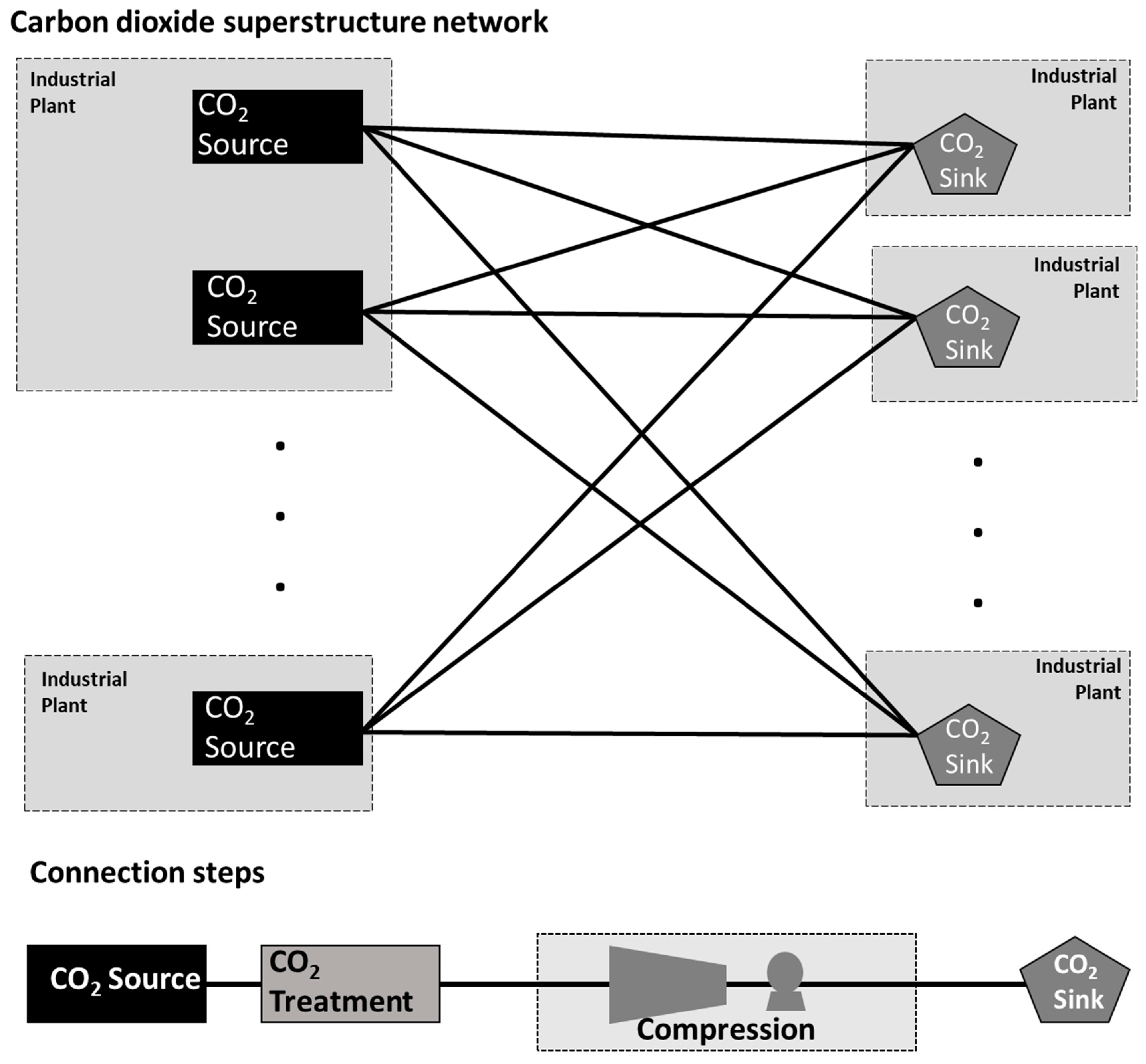

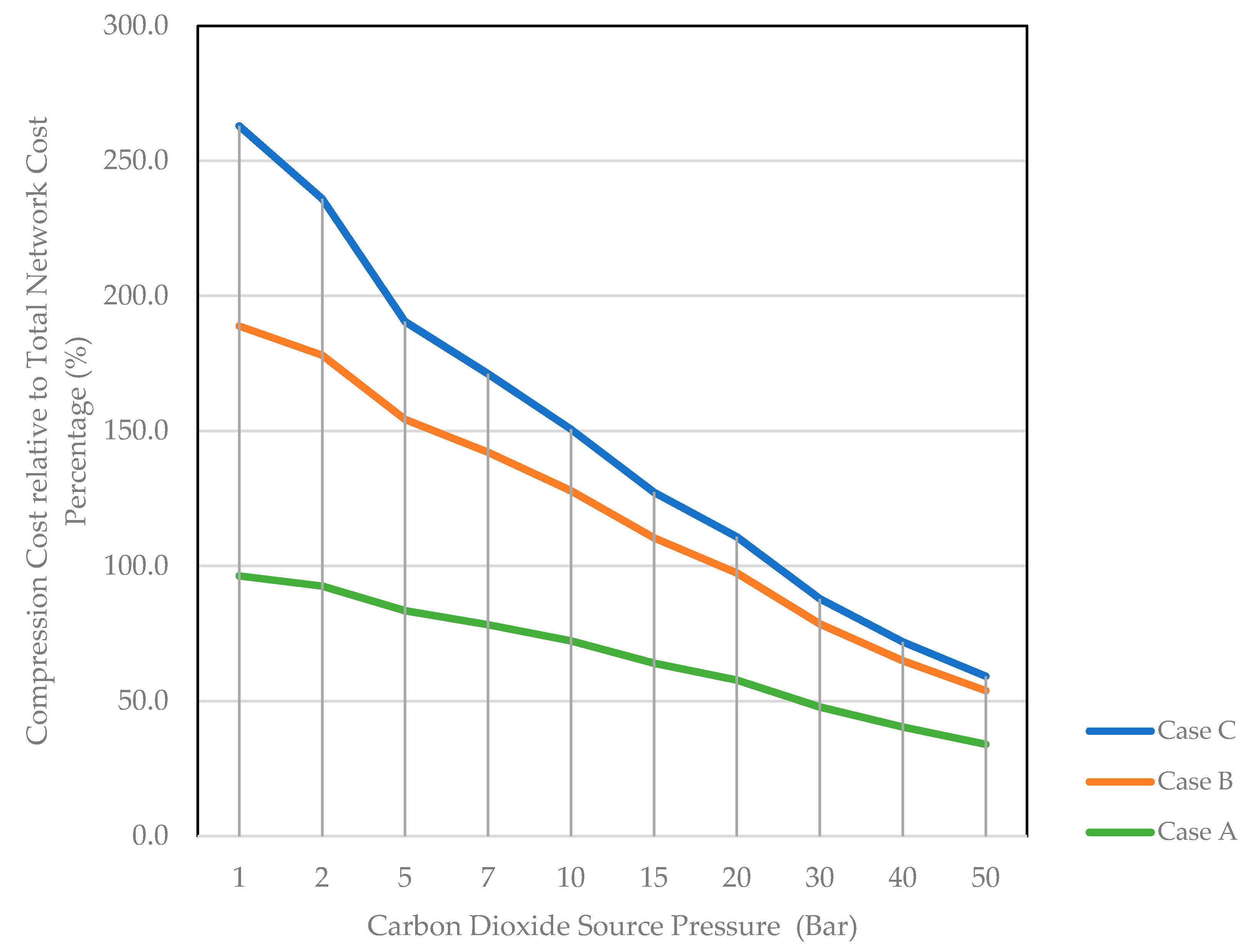

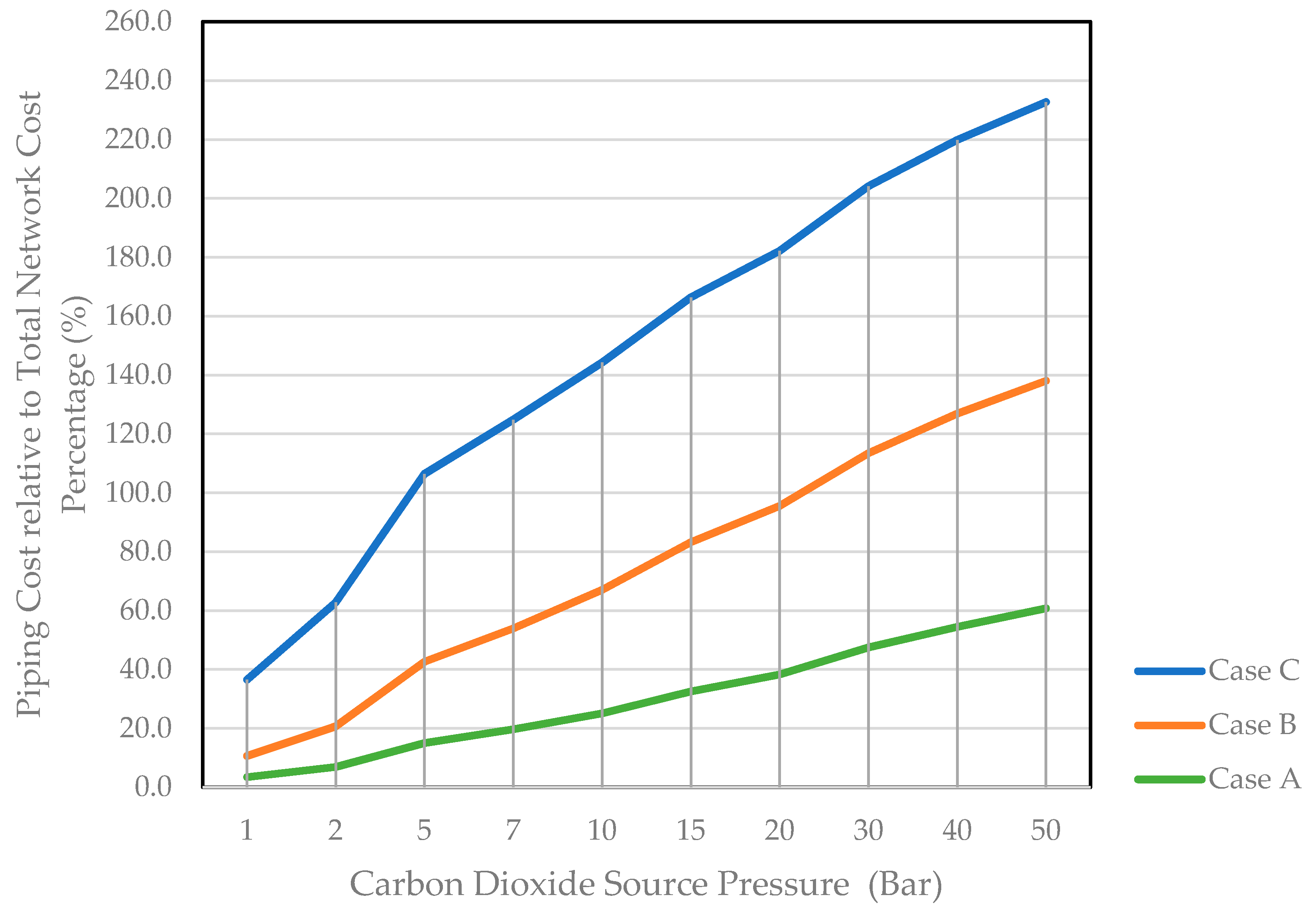
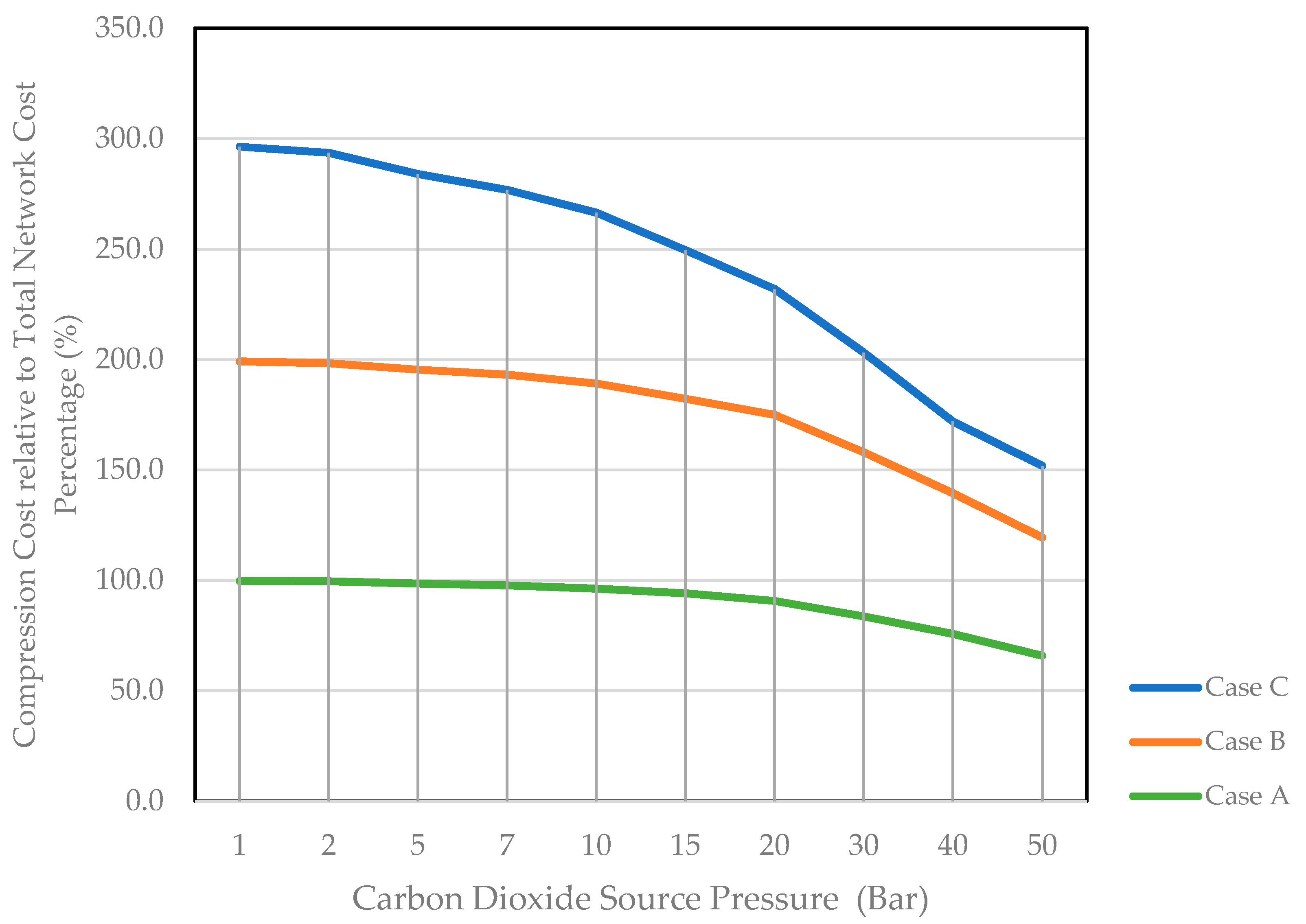
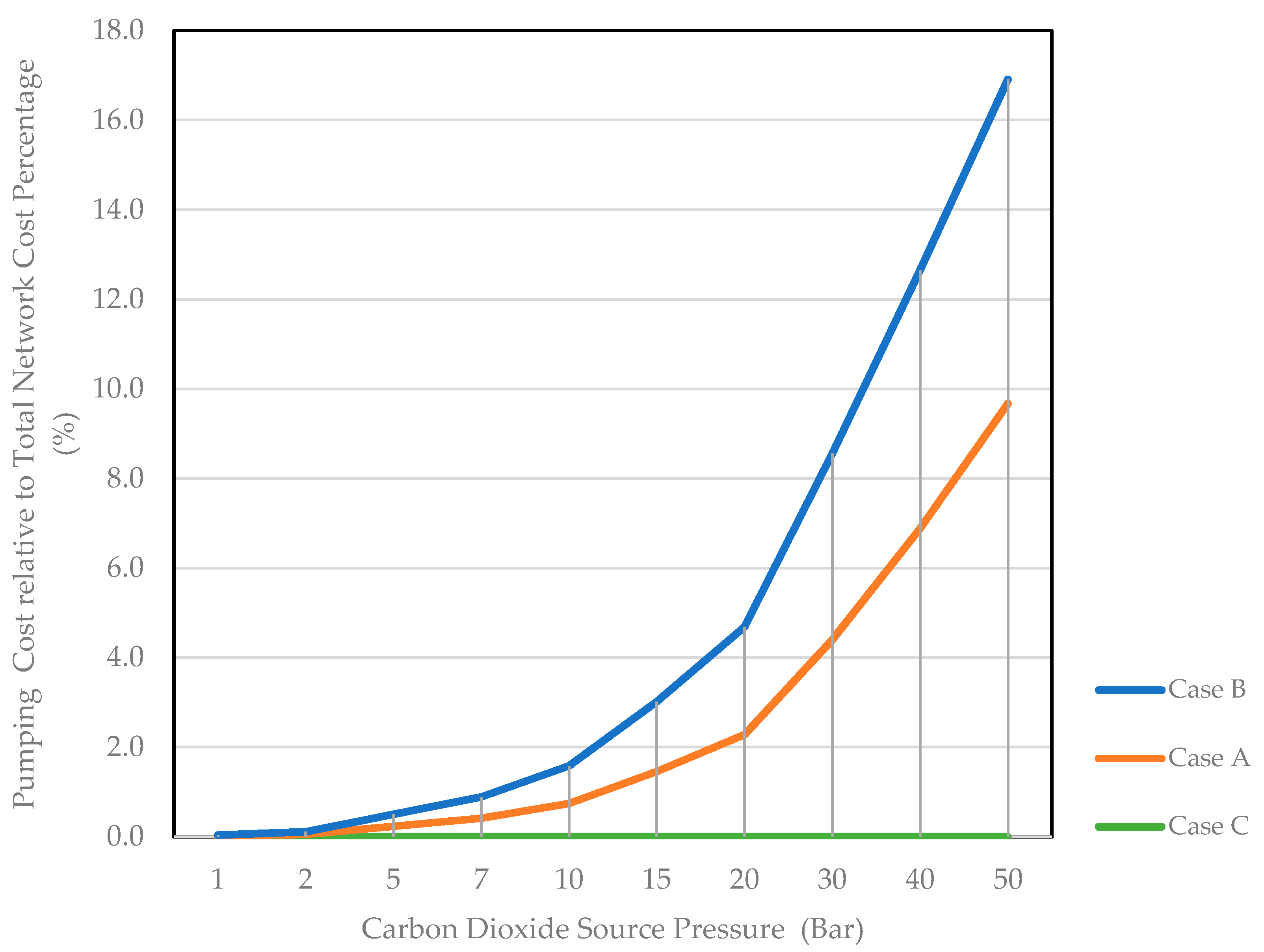
| CO2 Source * Number | Pressure | |||||||||
|---|---|---|---|---|---|---|---|---|---|---|
| 1 bar | 2 bar | 5 bar | 7 bar | 10 bar | 15 bar | 20 bar | 30 bar | 40 bar | 50 bar | |
| 1 | 67,416 | 33,520 | 13,319 | 9317 | 6414 | 4152 | 3017 | 1872 | 1285 | 914 |
| 2 | 44,944 | 22,346 | 8879 | 6211 | 4276 | 2768 | 2012 | 1248 | 857 | 609 |
| 3 | 78,652 | 39,106 | 15,538 | 10,870 | 7483 | 4844 | 3520 | 2184 | 1499 | 1066 |
| 4 | 44,944 | 22,346 | 8879 | 6211 | 4276 | 2768 | 2012 | 1248 | 857 | 609 |
| 5 | 109,551 | 54,469 | 21,643 | 15,140 | 10,422 | 6747 | 4903 | 3043 | 2088 | 1484 |
| 6 | 56,180 | 27,933 | 11,099 | 7764 | 5345 | 3460 | 2514 | 1560 | 1071 | 761 |
| CO2 Sink ** Number | Pressure | ||
|---|---|---|---|
| 151 bar | 101 bar | 74 bar | |
| 1 | 137 | 147 | 158 |
| 2 | 91 | 98 | 105 |
| 3 | 91 | 98 | 105 |
| 4 | 160 | 171 | 184 |
| 5 | 91 | 98 | 105 |
| 6 | 222 | 238 | 257 |
| Source | Y1 | Y2 | Y3 | Sink | Z1MAX | Z2MAX | Z3MAX |
|---|---|---|---|---|---|---|---|
| 1 | 0 | 0 | 30 | 1 | 100 | 50 | 30 |
| 2 | 50 | 50 | 80 | 2 | 140 | 100 | 60 |
| 3 | 50 | 70 | 100 | 3 | 180 | 150 | 130 |
| 4 | 140 | 100 | 100 | 4 | 230 | 180 | 180 |
| 5 | 170 | 120 | 130 | 5 | 250 | 190 | 200 |
| 6 | 240 | 130 | 150 | 6 | 100 | 190 | 210 |
| Cases | Source Pressure (bar) | Pipeline Costs | Pumping Costs | Compression Costs | Total Network Costs |
|---|---|---|---|---|---|
| Case A: Sink Pressure = 15,148 kPa | 1 | 154,979,765 | 11,784,526 | 87,205,902,838 | 87,372,667,129 |
| 2 | 131,447,518 | 11,706,826 | 35,559,532,020 | 35,702,686,364 | |
| 5 | 112,478,369 | 11,629,126 | 12,499,282,829 | 12,623,390,324 | |
| 7 | 108,466,438 | 11,473,726 | 8,645,385,233 | 8,765,325,397 | |
| 10 | 103,768,504 | 11,078,233 | 5,980,650,478 | 6,095,497,216 | |
| 15 | 100,617,625 | 10,745,233 | 3,960,957,219 | 4,072,320,077 | |
| 20 | 97,819,208 | 10,301,233 | 2,953,429,063 | 3,061,549,505 | |
| 30 | 95,508,090 | 9,524,233 | 1,924,839,835 | 2,029,872,158 | |
| 40 | 93,168,585 | 8,747,233 | 1,382,392,876 | 1,484,308,694 | |
| 50 | 91,706,690 | 7,970,233 | 1,027,484,015 | 1,127,160,939 | |
| Case B: Sink Pressure = 10,148 kPa | 1 | 187,380,366 | 7,899,526 | 48,592,697,183 | 48,787,977,077 |
| 2 | 160,179,190 | 7,821,826 | 19,814,410,667 | 19,982,411,683 | |
| 5 | 135,705,463 | 7,588,726 | 6,964,825,152 | 7,108,119,342 | |
| 7 | 129,318,545 | 7,433,326 | 4,817,364,111 | 4,954,115,983 | |
| 10 | 125,663,808 | 7,193,233 | 3,332,525,989 | 3,465,383,031 | |
| 15 | 120,492,769 | 6,804,733 | 2,207,116,588 | 2,334,414,091 | |
| 20 | 118,877,115 | 6,416,233 | 1,645,703,782 | 1,770,997,131 | |
| 30 | 115,220,013 | 5,639,233 | 1,072,555,368 | 1,193,414,615 | |
| 40 | 113,592,532 | 4,862,233 | 770,294,168 | 888,748,934 | |
| 50 | 111,607,856 | 4,085,233 | 572,532,569 | 688,225,658 | |
| Case C: Sink Pressure = 7380 kPa | 1 | 221,084,373 | 0 | 12,605,088,021 | 12,826,172,394 |
| 2 | 186,736,944 | 0 | 5,139,916,181 | 5,326,653,125 | |
| 5 | 159,041,372 | 0 | 1,806,696,051 | 1,965,737,423 | |
| 7 | 152,715,957 | 0 | 1,249,638,365 | 1,402,354,322 | |
| 10 | 146,565,591 | 0 | 864,467,006 | 1,011,032,596 | |
| 15 | 141,408,745 | 0 | 572,532,510 | 713,941,255 | |
| 20 | 138,139,589 | 0 | 426,900,383 | 565,039,972 | |
| 30 | 135,109,351 | 0 | 278,224,005 | 413,333,356 | |
| 40 | 132,831,350 | 0 | 199,816,564 | 332,647,914 | |
| 50 | 130,896,350 | 0 | 148,516,626 | 279,412,976 |
| Cases | Source Pressure (bar) | Pipeline Costs | Pumping Costs | Compression Costs | Total Network Costs |
|---|---|---|---|---|---|
| Case A: Sink Pressure = 15,148 kPa | 1 | 208,080,964 | 11,779,723 | 74,508,938,510 | 74,728,799,197 |
| 2 | 116,586,392 | 11,702,023 | 23,035,120,868 | 23,163,409,283 | |
| 5 | 66,149,503 | 11,468,923 | 4,886,257,289 | 4,963,875,715 | |
| 7 | 52,890,594 | 11,313,523 | 2,680,743,924 | 2,744,948,040 | |
| 10 | 46,156,491 | 11,073,430 | 1,431,627,451 | 1,488,857,371 | |
| 15 | 32,742,953 | 10,684,930 | 689,613,261 | 733,041,144 | |
| 20 | 32,040,774 | 10,296,430 | 409,039,754 | 451,376,957 | |
| 30 | 25,877,762 | 9,519,430 | 180,928,226 | 216,325,417 | |
| 40 | 22,138,768 | 8,742,430 | 96,153,615 | 127,034,812 | |
| 50 | 20,196,990 | 7,965,430 | 54,187,100 | 82,349,519 | |
| Case B: Sink Pressure = 10,148 kPa | 1 | 264,208,192 | 7,894,723 | 41,517,720,345 | 41,789,823,259 |
| 2 | 143,061,128 | 7,817,023 | 12,835,583,561 | 12,986,461,712 | |
| 5 | 78,388,594 | 7,583,923 | 2,722,710,425 | 2,808,682,942 | |
| 7 | 64,412,455 | 7,428,523 | 1,493,758,719 | 1,565,599,696 | |
| 10 | 53,025,708 | 7,188,430 | 797,728,559 | 857,942,696 | |
| 15 | 44,776,125 | 6,799,930 | 384,264,910 | 435,840,965 | |
| 20 | 35,332,471 | 6,411,430 | 224,742,760 | 266,486,661 | |
| 30 | 29,204,020 | 5,634,430 | 100,816,461 | 135,654,911 | |
| 40 | 25,662,672 | 4,857,430 | 53,578,523 | 84,098,625 | |
| 50 | 22,093,606 | 4,080,430 | 30,194,026 | 56,368,061 | |
| Case C: Sink Pressure = 7380 kPa | 1 | 299,208,375 | 0 | 10,769,818,300 | 11,069,026,674 |
| 2 | 164,367,170 | 0 | 3,329,587,983 | 3,493,955,153 | |
| 5 | 90,291,391 | 0 | 706,279,062 | 796,570,453 | |
| 7 | 75,135,176 | 0 | 387,485,388 | 462,620,564 | |
| 10 | 60,681,811 | 0 | 206,933,125 | 267,614,937 | |
| 15 | 48,553,531 | 0 | 99,679,443 | 148,232,974 | |
| 20 | 44,103,086 | 0 | 58,298,930 | 102,402,016 | |
| 30 | 31,769,896 | 0 | 26,152,085 | 57,921,981 | |
| 40 | 28,928,652 | 0 | 13,898,426 | 42,827,078 | |
| 50 | 28,928,652 | 0 | 13,898,426 | 42,827,078 |
© 2020 by the authors. Licensee MDPI, Basel, Switzerland. This article is an open access article distributed under the terms and conditions of the Creative Commons Attribution (CC BY) license (http://creativecommons.org/licenses/by/4.0/).
Share and Cite
Alnouri, S.Y.; Al-Mohannadi, D.M. Exploring Tradeoffs in Merged Pipeline Infrastructure for Carbon Dioxide Integration Networks. Sustainability 2020, 12, 2678. https://doi.org/10.3390/su12072678
Alnouri SY, Al-Mohannadi DM. Exploring Tradeoffs in Merged Pipeline Infrastructure for Carbon Dioxide Integration Networks. Sustainability. 2020; 12(7):2678. https://doi.org/10.3390/su12072678
Chicago/Turabian StyleAlnouri, Sabla Y., and Dhabia M. Al-Mohannadi. 2020. "Exploring Tradeoffs in Merged Pipeline Infrastructure for Carbon Dioxide Integration Networks" Sustainability 12, no. 7: 2678. https://doi.org/10.3390/su12072678
APA StyleAlnouri, S. Y., & Al-Mohannadi, D. M. (2020). Exploring Tradeoffs in Merged Pipeline Infrastructure for Carbon Dioxide Integration Networks. Sustainability, 12(7), 2678. https://doi.org/10.3390/su12072678




